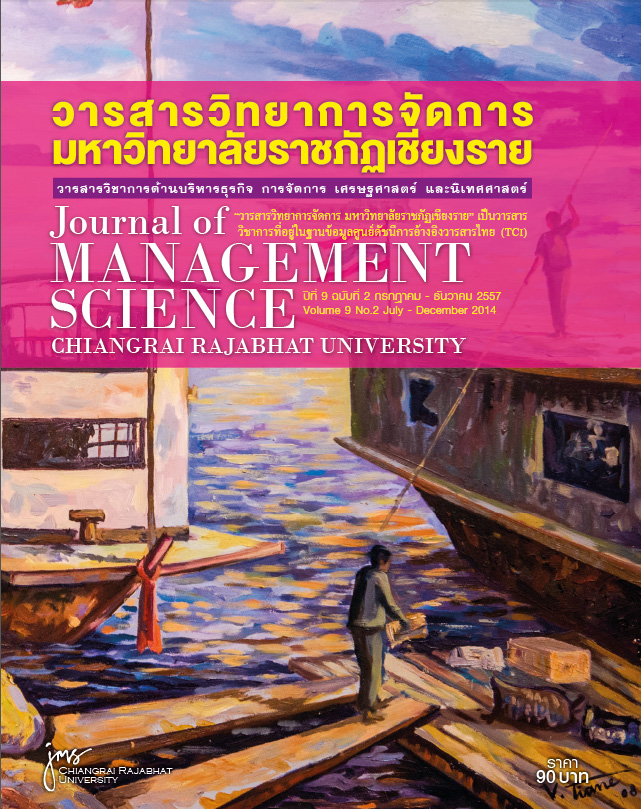Information Seeking with Four Screen in Media Convergence
Main Article Content
Abstract
Currently, the society has become the age of information in which people need to communicate to each other all the time without limited time, places, distances and expenses. It is a new life style which depends on new technology in order to increase communication. Therefore, ‘4 screen’ is an innovation which is playing an important role on daily life of people especially, those who consume media through the screens of 4 screen such as a screen of a television, a screen of a computer, a screen of tablet and of a mobile phone in form of multi-screen. The multi-screen can be linked to social network. Each screen has different functions based on use and gratification by users. Consequently, receivers have become their role from passive audiences to active seeking in order to serve their satisfaction. This has brought Media Convergence which merges technology of computer, internet including mass media like newspaper, entertainment, and music to turn into new media where users have a lot of freedom to specify contents and the ways to apply it through social network on the cyberspace.
Article Details
Views and opinions expressed in the journal do not necessarily reflect those of the editors.
References
กาญจนา แก้วเทพ และสมสุข หินวิมาน. (2550). สายธารแห่งนักคิดทฤษฎีเศรษฐศาสตร์การเมืองกับสื่อสารศึกษา.กรุงเทพมหานคร: ห้างหุ้นส่วนจำกัดภาพพิมพ์. ชานนท์ ศิริธร. (2554). การเปิดรับสื่อและการยอมรับนวัตกรรมของผู้บริโภคเจเนอเรชั่นเอ็กซ์ และเจเนอเรชั่นวาย. (วิทยานิพนธ์ปริญญามหาบัณฑิต สาขาวิชานิเทศศาสตร์จุฬาลงกรณ์มหาวิทยาลัย). กรุงเทพมหานคร : บัณฑิตวิทยาลัยจุฬาลงกรณ์มหาวิทยาลัย. ณัฐจิตต์ บูราณทวีคูณ. (2556). “4 Screen 4 หน้าจอทะลุมิติ,” Marketeer. ปี ที่14 ฉบับที่ 162:105
ธาม เชื้อสถาปนาศิริ. (2557). เด็กเรียนร้อย่างไรในย ู ุคสื่อหลอมรวม. งานประชุมวิชาการ “อภิวัฒน์การเรียนรู้สู่จุดเปลี่ยนประเทศไทย”ระหวางวันที่ ่ 6-8พฤษภาคม สืบค้นจาก http://www.isranews.org/thaireform-news-mass-comm/item/29184-media07.html
ปาริชาต สายธนู.(2553). ลักษณะการดำเนินชีวิตของกลุ่มผู ้ใช้เทคโนโลยีหลอมรวมสื่อ. (วิทยานิพนธ์ปริญญานิเทศศาสตรดุษฎีบัณทิต).กรุงเทพมหานคร : บัณฑิตวิทยาลัยจุฬาลงกรณ์มหาวิทยาลัย. มหาวิทยาลัยสุโขทัยธรรมาธิราช. (2555).การสื่อสารกับการพัฒนา. สาขาวิชานิเทศศาสตร์
มหาวิทยาลัยสุโขทัยธรรมาธิราชหน่วยที่ 1-8. กรุงเทพมหานคร: มหาวิทยาลัยสุโขทัยธรรมาธิราช. สรเกียรติ คณารัตน์(2557).“InnovativeActivation,Muti-Screen Engagement”Marketeer. ปี ที่14 ฉบับที่168 : 190-120. อริยะ พนมยงค์(2556). “Google ยุคใหม่ของโฆษณาที่นักการตลาดควรรู้,” Marketeer. ปีที่14 ฉบับที่162 : 108-109 . Atkin, Charl K. (1962). Anticipated Communication and Mass media Information Seeking. Public Opion Quartery. New York :FreePress,. Convergence & Computing Technology from http://evirtualguru.com/convergencecomputing-technology/Digital Age/Technology Acceptance Model from http://en.wikiversity.org/wiki/Digital_Age/Technology_Acceptance_Model Kolko, B. and Reid, E.(1998). Dissolution and Fragmentation: Problems In On-Line Communities.,Steven G.Jones.(Editor). Cybersociety2.0 Revisting ComputerMediated Communication and Community. USA: SAGE Publications, : 212-218. McQuail, D.(2005) .McQuail’s Mass Communication Theory.5thed., London:SAGE Publications.
Rogers, E. M. (2003). Diffusion of Innovations.5 thed., New York :FreePress. Williams, K.(2003) . Understanding Media Theory. London : Arnol, the Hodder Headline Group.


